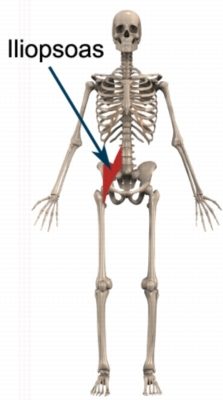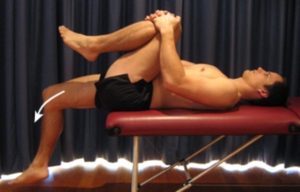Hip Flexor Strain
Updated:
(Also known as Hip Flexor Injury, Iliopsoas Strain, Psoas Strain, Hip Flexor Tear, Strained Iliopsoas Muscle, Torn Iliopsoas Muscle, Pulled Hip Flexor)
What is a hip flexor strain?
A hip flexor strain is an injury characterised by tearing of one or more of the hip flexor muscles and typically causes pain in the front of the hip or groin.
The group of muscles at the front of the hip are called the hip flexors. The hip flexors comprise of 3 major muscles:
- The iliacus and psoas muscles, collectively known as the iliopsoas.
- The rectus femoris which is part of the quadriceps muscle.
The most commonly involved muscle in a hip flexor strain is the iliopsoas (figure 1). The iliopsoas muscle originates from the lower back and pelvis and inserts into the thigh bone (femur).

The hip flexors are responsible for moving the knee towards the chest during activity (i.e. bending the hip) and are particularly active when sprinting or kicking. Whenever the hip flexors contract or are put under stretch, tension is placed through the hip flexor muscle fibres. When this tension is excessive due to too much repetition or high force, the hip flexor muscle fibres may tear. When this occurs, the condition is known as a hip flexor strain.
Tears to the hip flexor muscles can range from a small partial tear where there is minimal pain and minimal loss of function, to a complete rupture involving a sudden episode of severe pain and significant disability.
Hip flexor strains range from grade 1 to grade 3 and are classified as follows:
- Grade 1 Tear: a small number of fibres are torn resulting in some pain, but allowing full function.
- Grade 2 Tear: a significant number of fibres are torn with moderate loss of function.
- Grade 3 Tear: all muscle fibres are ruptured resulting in major loss of function.
The majority of hip flexor strains are grade 2.
Causes of a hip flexor strain
Hip flexor strains most commonly occur due to a sudden contraction of the hip flexor muscles (particularly in a position of stretch). They often occur during sprinting or kicking activities. This is particularly so during explosive acceleration or when a footballer performs a long kick, particularly following an inadequate warm-up.
Occasionally, patients may develop this condition gradually due to repetitive or prolonged strain on the hip flexor muscles. This may occur due to repetitive kicking or sprinting excessively. Hip flexor strains are commonly seen in running and kicking sports such as football, soccer, dancing and martial arts.
Signs and symptoms of a hip flexor strain
Patients with this condition usually feel a sudden sharp pain or pulling sensation in the front of the hip or groin at the time of injury. In minor strains, pain may be minimal allowing continued activity. In more severe cases, patients may experience severe pain, muscle spasm, weakness and an inability to continue the activity. Patients with a severe hip flexor strain may also be unable to walk without limping.
Patients with this condition usually experience pain when lifting the knee towards the chest (especially against resistance) or during activities such as running, kicking or going upstairs. It is also common for patients to experience pain or stiffness after these activities with rest, especially upon waking in the morning. Swelling, tenderness and bruising may also be present in the hip flexor muscles. In cases of a grade 3 tear a visible and palpable deformity in the muscle may be evident.
Diagnosis of a hip flexor strain
A thorough subjective and objective examination from a physiotherapist is usually sufficient to diagnose a hip flexor strain. Further investigations such as an X-ray, Ultrasound, MRI or CT scan may be required to confirm diagnosis and exclude other pathology (such as a labral tear of the hip, femoro-acetabular impingement or hip osteoarthritis). In severe cases, particularly adolescents, an X-ray may be advisable to exclude the possibility of an avulsion fracture. Investigations are often not routinely indicated, unless:
- other more serious pathology is suspected
- it’s likely to change clinical management
- there has been a significant period of failed conservative physiotherapy management
Treatment for a hip flexor strain

Members Only ContentBecome a PhysioAdvisor Member to gain full access to this exclusive content. For more details see Become a Member. Already a member? Login Now
Prognosis of a hip flexor strain
With appropriate management, patients with a minor hip flexor strain can usually recover in one to three weeks. With larger tears, recovery may take four to eight weeks or longer depending on the severity. Complete ruptures of the hip flexor muscles are rare and are usually managed conservatively. In these cases, recovery may be significantly longer.
Contributing factors to the development of a hip flexor strain
There are several factors which can predispose patients to developing this condition. These need to be assessed and corrected with direction from a physiotherapist. Some of these factors include:
- muscle weakness (particularly of the quadriceps, hip flexors or gluteals)
- muscle tightness (particularly of the hip flexors, quadriceps, hamstrings or gluteals)
- inappropriate or excessive training or activity
- inadequate recovery periods from training or activity
- inadequate warm up
- joint stiffness (especially the lower back, hip or knee)
- poor biomechanics
- poor posture
- inadequate rehabilitation following a previous hip flexor injury
- decreased fitness
- fatigue
- poor pelvic and core stability
- neural tightness
- muscle imbalances
Physiotherapy for a hip flexor strain
Physiotherapy for patients with this condition is vital to hasten the healing process, ensure an optimal outcome and reduce the likelihood of recurrence. Treatment may comprise:
- soft tissue massage
- electrotherapy (e.g. ultrasound)
- joint mobilisation (especially the lower back and hip)
- stretches
- dry needling
- anti-inflammatory advice
- the use of crutches
- ice or heat treatment
- progressive exercises to improve strength and flexibility (particularly of the hip flexors)
- hydrotherapy
- education
- biomechanical correction
- activity modification advice
- establishment of an appropriate return to activity, return to running or return to sport plan
Other intervention for a hip flexor strain
Despite appropriate physiotherapy management, some patients with a hip flexor injury do not improve adequately. When this occurs, the treating physiotherapist or doctor can advise on the best course of management. This may include investigations such as an X-ray, ultrasound, CT scan or MRI, or referral to appropriate medical authorities who can advise on any intervention that may be appropriate to improve the condition.
Exercises for a hip flexor strain
The following exercises are commonly prescribed to patients with this condition. You should discuss the suitability of these exercises with your physiotherapist prior to beginning them. Generally, they should be performed 3 times daily and only provided they do not cause or increase symptoms.
Your physiotherapist can advise when it is appropriate to begin the initial exercises and eventually progress to the intermediate and advanced exercises. As a general rule, addition of exercises or progression to more advanced exercises should take place provided there is no increase in symptoms.
Initial Exercises
Hip Flexion
Slowly take your knee towards your chest as far as possible and comfortable without pain (figure 2). Repeat 10 times provided there is no increase in symptoms.

Hip Extension in Lying
Begin lying on your back, with your buttocks at the very edge of a bench or bed. Take your good knee towards your chest as far as possible, letting your injured leg drop down towards the floor (figure 3). Hold for 2 – 5 seconds at a mild to moderate stretch and repeat 10 times provided the exercise is pain free.

Intermediate Exercises

Members Only ContentBecome a PhysioAdvisor Member to gain full access to this exclusive content. For more details see Become a Member. Already a member? Login Now
Advanced Exercises

Members Only ContentBecome a PhysioAdvisor Member to gain full access to this exclusive content. For more details see Become a Member. Already a member? Login Now
Rehabilitation guide for a hip flexor strain

Members Only ContentBecome a PhysioAdvisor Member to gain full access to this exclusive content. For more details see Become a Member. Already a member? Login Now
 Find a Physio
Find a Physio
Find a physiotherapist in your local area who can treat this condition.
 Physiotherapy products for a hip flexor strain
Physiotherapy products for a hip flexor strain
The most commonly recommended products by physiotherapists to hasten healing and speed recovery in patients with this condition include:
To purchase physiotherapy products for a hip flexor strain click on one of the above links or visit the PhysioAdvisor Shop.
 More information
More information
- Hip Flexor Stretches.
- Hip Flexor Strengthening Exercises.
- Beginner Pilates Exercises to improve your core stability and posture.
- View detailed information on How to use Crutches.
- Learn about when to use Ice or Heat.
- View our Hip and Groin Diagnosis Guide.
- Wondering Why is my Injury not Improving?
Become a PhysioAdvisor Member
+ 7 References
PhysioAdvisor relies on credible scientific sources (ideally from high quality, randomised controlled trials, when available) to guide our content creation. Read about our sourcing guidelines and how we create trusted content via our editorial policy.
- Brukner et al (2012). Brukner & Khan’s clinical sports medicine (4th ed.), 565. Australia: McGraw Hill Education.
- Bui, K.L., Ilaslan, H., Recht, M. et al. (2008). Iliopsoas injury: an MRI study of patterns and prevalence correlated with clinical findings. Skeletal Radiology, 37(3): 245. https://doi.org/10.1007/s00256-007-0414-3
- Eckard TG et al. (2017). Epidemiology of Hip Flexor and Hip Adductor Strains in National Collegiate Athletic Association Athletes, 2009/2010-2014/2015.Am J Sports Med. 2017 Oct;45(12):2713-2722. https://doi.org/10.1177/0363546517716179.
- Understanding Hip Flexor Strain (2017) – healthline.com/health/hip-flexor-strain
- Hip flexor strain. (2014). summitmedicalgroup.com/library/adult_health/sma_iliopsoas_tendonitis/
- Cadman, B. (2018). “All you need to know about hip flexor strain.” Medical News Today. Retrieved from medicalnewstoday.com/articles/320655.php.
- Hip pain in adults. (2016). nhs.uk/conditions/hip-pain/

Link to this Page
If you would like to link to this article on your website, simply copy the code below and add it to your page:
<a href="https://physioadvisor.com.au/injuries/hip-groin/hip-flexor-strain”>Hip Flexor Strain – PhysioAdvisor.com</a><br/>PhysioAdvisor offers detailed physiotherapy information on a hip flexor strain including: diagnosis, treatment, exercises, physiotherapy products and more...
Return to the top of Hip Flexor Strain.








